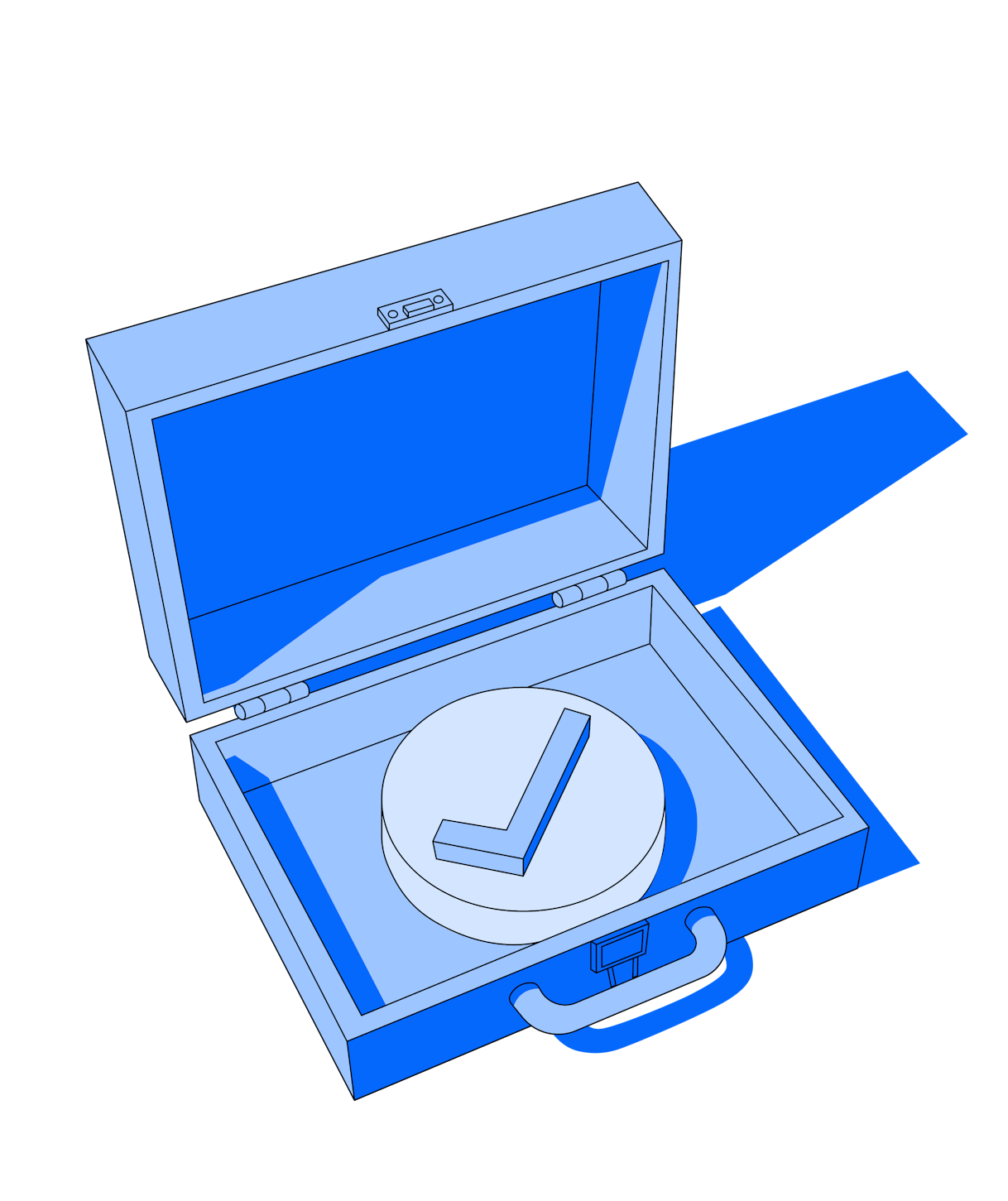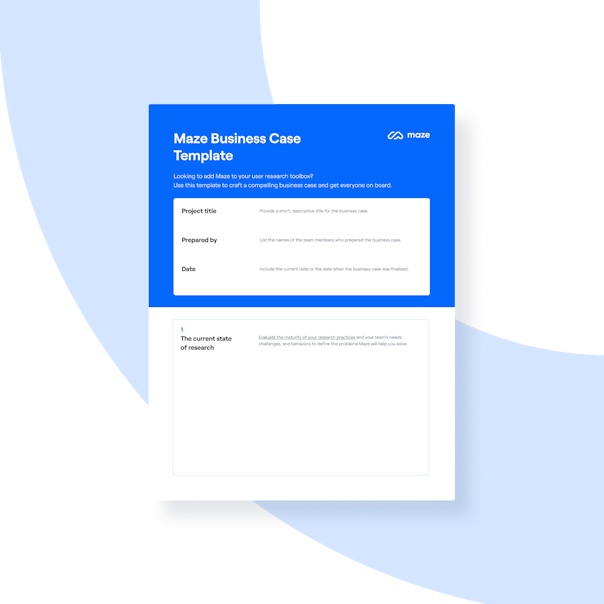If you're reading this, chances are you're considering adding Maze to your research toolbox. As a research leader myself, I understand the factors involved in implementing a new user research platform. From gaining stakeholder alignment to navigating budget approvals and legal reviews, there's a lot to consider. Often, on larger teams, this process can take upwards of months.
To help you and your team move forward with the right tool for your research practice, we put together a step-by-step guide and free template for building a solid business case for Maze. Whether it's driving stakeholder alignment or crafting your implementation plan, we have everything you need to get started.
Why do you need a business case?
As a champion advocating for a new user research tool for your company, you are facilitating the entire purchase and implementation journey for your team. Writing a compelling business case is the initial step you'll want to take to turn your vision into a reality.
A business case is a document or presentation that outlines the reasons for starting a project, program, or initiative. As the champion, you’re likely aware of the benefits of choosing a tool like Maze, but your company’s stakeholders may not be familiar with the advantages.
Your business case will serve as a foundation for demonstrating the value of the tool you're advocating for. It’s about putting everything in black and white about why the project is worth the time and money investment.
How to write a business case for Maze in 9 steps
Creating a business case will tell the complete story of why purchasing Maze is a good idea for your business. If this is your first time creating a business case, we’re here to help. Here are nine steps to help break this process down for you and your team:
1. Understand the current state of your research practice
Making a case for a new user research tool is no small feat. You're proposing a shift in your team's behavior and how they carry out their jobs at work.
The first step I always recommend to leaders looking to implement any changes across their research practice is to dig into the current team dynamics. By assessing your team's needs, challenges, and behaviors, you can clearly define the problems a tool like Maze will help you solve.
Just like when running a research study, there's a few different ways you can gather information about the current state of your research practice, including observing existing work, interviewing stakeholders, running a team pulse survey, or taking a research maturity assessment.
Regardless of the method, here are some questions to consider:
- What does your product development process currently look like?
- What research tools is the team currently using?
- How's your team collaborating around research?
- What's working/not working with your existing tools or processes?
- What type of research do stakeholders need to make informed decisions?
- What’s the team's knowledge and experience in user research?
- What is the impact of continuing to stick with the status quo?
Once you have identified these areas, you're ready to move forward.
See where your organization lands on the research maturity curve and what you can do to advance your research practices. Maze's Research Maturity Model defines five levels of research maturity across three key dimensions: People, Process, and Impact.
2. Set your vision, goals, and success measures
Next, you’ll want to outline your vision, goals for the future, and success measures.
Your vision is the end goal that you hope to achieve through purchasing Maze. When working with clients, I'll often ask them, “If you could wave a magic wand, what do you want your research practice to look like [a year] from now? The sky’s the limit. If there were no constraints, what does success look like to you and your team?” I’ll often hear things like: We want an all-in-one tool that's intuitive enough for designers to use so they can quickly get feedback from customers.
Once you've answered these questions, take time to create goals based on your vision. For example, if your vision is scaling user research across the organization, a goal could be: Each designer speaks to two customers per week to help derisk upcoming work.
Finally, discuss measurable objectives. You’ll want to get specific about how you and your team plan to measure success for this initiative. For example, you could track:
Number of studies conducted
Number of customers connected with
3. Compare possible solutions
As a next step, you'll want to put together a list of requirements for your new user research tool. These are likely going to be product features that are the highest priority for you and your team, like integrations or automated reporting. You may also have specific legal and security requirements from your wider company. I recommend getting your requirements into spreadsheet format. From there you can list each requirement as a nice-to-have vs. need-to-have.
Once you have your requirements list, you’ll want to go out and explore different UX research tools that you could use. After all, there’s always more than one way to solve a problem.
This will show stakeholders that you’ve evaluated various options before providing your recommendations. I often present my comparisons in a spreadsheet format, where I create dedicated columns for each tool, including information on the pros and cons, risks, costs involved, and any key criteria the team may list as high priority.
Make a copy of our Vendor Comparison Matrix and use it to compare Maze to other vendors. You can download and customize the comparison template here.
4. Recommend your ideal solution
After your evaluation of the available UX research tools, you’ve likely identified a clear winner and are ready to make a proposal for your recommended solution.
When sharing with your team why Maze is the best fit for the job, you’ll want to make sure to share information like an overview of the platform, product features that led to choosing it, cost, benefits, and overall fit of the tool with the team.
Example:
We've decided to move forward with Maze as a tool for the team. Maze is the leading user research platform that helps companies build the right products faster by making user insights available at the speed of product development. Built for ease of use, it allows designers, product managers, and researchers to collect and share user insights when needed most—putting them at the center of every decision.
From its intuitive interface to its robust analytics capabilities, Maze offers a comprehensive suite of features designed to streamline your research workflows. Unlike other user research tools on the market, it integrates quantitative and qualitative research, panel and recruitment, and automated reporting all in one platform.
Looking for a summary of the top reasons to choose Maze? Check out our article to see why leading organizations trust their user research to Maze and what sets it apart from the competition.
5. Set up your purchasing team
At this point, you can put together a "tiger team" of stakeholders to make this initiative come to life. You're going to want them to be executives who may have budgetary approval, legal and security teams, subject matter experts, and champions who can help promote the value of investing in UX research.
These leaders will be able to help you anticipate any roadblocks you may uncover and help roll out the tool across various teams down the road.
In this section of your business case, you should briefly discuss who’s going to be invested in the project and in what regard.
Example:
Tooling discovery and purchasing will be led by [...]. Stakeholders who need to be involved in this initiative are:
- VP of Product: Budgetary approval
- Lead User Researcher: Champion
- Product Designer: Champion
- Legal Council: Reviewing terms and conditions
6. Outline potential risks and challenges
Once you have your stakeholder group, I often recommend that teams have a brainstorming session to anticipate any possible risks or challenges. This is similar to a pre-mortem exercise, where you’d get proactive about any potential areas that could go wrong.
For example, I work with many research leaders who are looking to democratize research across their organization and purchase Maze to empower designers to conduct research. However, after making the purchase, they end up seeing low adoption rates across the team. This is a huge risk. To mitigate it, consider involving key champions from the design team earlier on during your evaluation phase to ensure that the tool meets their needs.
Some of my favorite questions to ask at this stage are:
- Imagine six months from now and this project has failed. What did we get wrong?
- What would the impact of this risk be?
- How can we mitigate this risk?
7. Describe your implementation plan
Now that you have everything laid out, you’ll want to put together your implementation plan. This will include a high-level overview of some of the major milestones you’ll need to hit as a team to make switching to Maze a success.
Your plan should include key dates, milestones, and owners. You can use a RACI matrix to clarify project roles and responsibilities across the team, keeping everyone informed every step of the way.
8. Get ahead of questions
There's lots of moving parts when it comes to purchasing a new tool. My advice is to get ahead of potential questions from your stakeholders by preparing resources for additional information they may ask for.
For example, consider getting a solid quote for the cost of your tool, gathering information about the tool’s legal and security policies, or find success stories from other companies like yours.
Here are some Maze resources you might find valuable:
9. Monitor and communicate your progress
The final step is to determine how you’ll monitor and report progress updates to your team. In the past, I’ve done this in a few ways:
- Creating a Slack channel with the core stakeholder group to discuss questions and share ad-hoc updates
- Scheduling bi-weekly status meetings with stakeholders to discuss the overall process and direction
- Organizing regular meetings with the tooling vendor to discuss any additional paperwork or requirements across the team
With any type of change, it’s always best to over-communicate vs. under.
Bring your business case to life with our free template
Successfully purchasing a tool requires strong internal alignment across your team. Creating a business case is a critical step to show that you have all of your bases covered and explain why this initiative truly matters to your team and the wider business.
With nine key areas that you can customize to suit your needs, the template below is the perfect tool for writing a business case for Maze and getting everyone on the same page.





